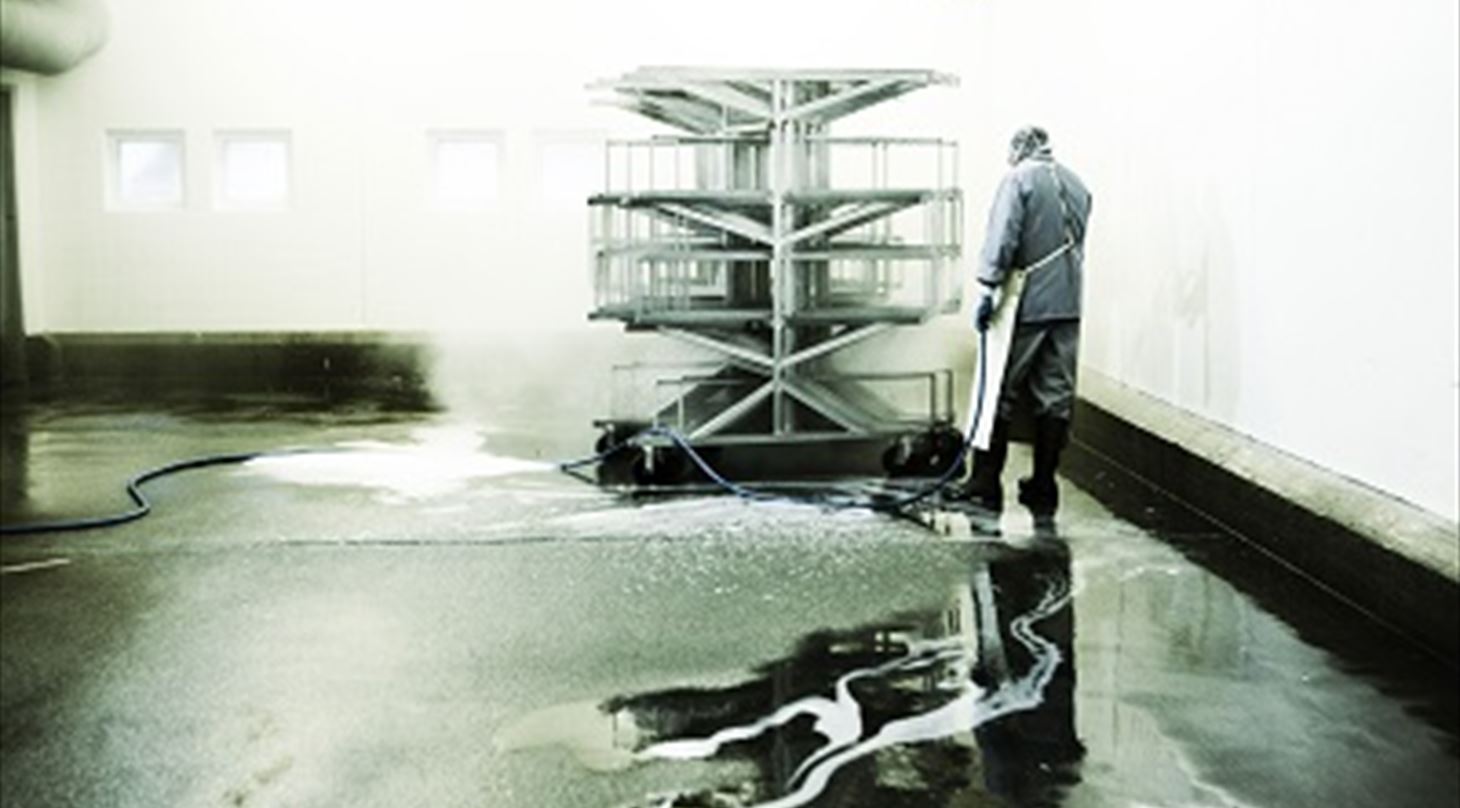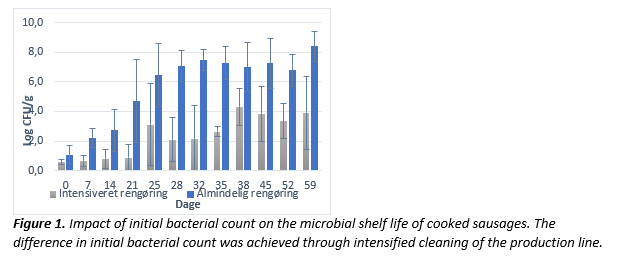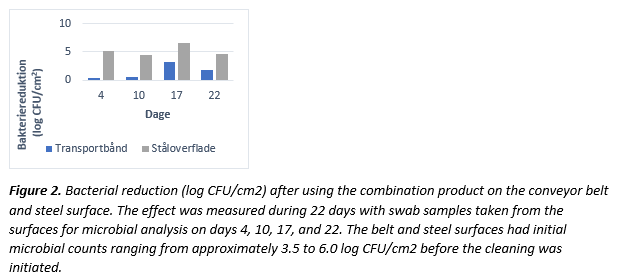
Cleaning in the food industry - Can it be made more sustainable?
The Danish Technological Institute has tested various solutions to reduce water and chemical consumption associated with cleaning in the food industry. wo criteria were established for the solutions:
1) The cleaning of production areas must not take longer
2) Cleaning quality must not be compromised.
The results showed that minor adjustments to the cleaning procedures, such as nozzle replacement, can have significant economic and environmental effects. However, the introduction of new cleaning and disinfection detergent should be approached with caution, as their effectiveness mostly depends on the surfaces they are used on.
The balance between sustainability and hygiene
Good production hygiene is a 'license to produce' if food manufacturers want to maintain their market segment and produce products with a high level of food safety and a long shelf life. Many food producers are now also considering how to optimize their production in terms of sustainability. Daily cleaning of production areas plays a central role in this, as a lot of water, energy and environmentally harmful chemicals are used. However, the introduction of water-saving measures or the use of more environmentally friendly chemicals should be done cautiously to avoid compromising cleaning quality.
Good cleaning can extend shelf life
Both product safety and shelf life heavily depend on the quality of cleaning performed in the production area. In fact, the shelf life of a product can be extended by weeks if the initial bacterial count is <10 CFU/g compared to 100 CFU/g. This can be illustrated by a series of experiments where the shelf life of cooked sausages more than doubled with intensified cleaning of the production line (Figure 1). Prior to intensified cleaning, the initial bacterial counts in the products ranged from <10 to 100 CFU/g (4 out of 10 packages with <10 CFU/g), and the product's shelf life was approximately one month. Intensified cleaning of the production line reduced the initial bacterial counts in the products to <10 CFU/g in 9 out of 10 packages, extending the products' microbial shelf life to over two months.

Save water by choosing the right nozzle
The cleaning process in many food industries is divided into five sub-routines: rough rinsing (removal of dirt), application of cleaning detergent, rinsing with water, disinfection (microbial inactivation), and final rinsing with water. The highest water consumption is often associated with the initial rough rinsing of equipment and floors, as it is a time-consuming process and nozzles with a high water consumption (40-50 l/min) are used.
The Danish Technological Institute (TI) tested whether water consumption for cleaning could be reduced by using a water-saving nozzle (30 l/min) for all three rinsing steps. The water-saving nozzle was used for 2 weeks in a Danish slaughterhouse in their deboning and cutting department. The test showed that water consumption was reduced by approximately 10% compared to usual consumption. Variations in the reductions were observed from day to day and between different cleaning stations depending on the task/equipment and the sanitation worker performing the task. The use of the water-saving nozzle did not extend the cleaning time in the department, and daily inspections of the production areas confirmed that the cleaning quality was not compromised.
A 10% reduction can also have a significant impact on energy consumption, as the facilities are rough-rinsed with lukewarm water (45-55°C). During the production day, most food companies reuse heat, especially from cooling processes, to heat water for cleaning. This heating method can cover the heating of most of the cleaning water, but the marginal water consumption for cleaning, which needs to be heated with oil or gas outside production hours, is considerably more expensive than the water that can be heated during production hours. Thus, even a relatively modest water saving can have a very large economic value for the company, especially in the current energy situation.
Combined cleaning and disinfection
Cleaning and disinfection can be combined into one step instead of using separate products with intermediate rinsing. The use of combination products leads to savings in water as well as in chemical and time consumption. These products are often based on an alkaline foam cleaning detergent with added chlorine. Chlorine is effective in removing embedded dirt, and it is a highly efficient disinfectant with a broad-spectrum effect against a wide range of microorganisms. However, the disinfection effectiveness of chlorine depends greatly on the amount of dirt present. The more dirt there is on the surfaces, the less effective chlorine is in inactivating microorganisms.
TI tested the effectiveness of a combination product in a pilot plant setup, simulating the conditions in a production area with a low level of dirt (e.g., packaging area in the meat industry). The test was conducted using the same cleaning equipment and settings used in the industry, including water pressure (25 bar), water temperature and corresponding cleaning and rinsing nozzles. The long-term effect of the combination product was tested on both steel surfaces and a plastic lamella belt (conveyor belt) using the following routine:
- The surfaces were soiled with pork belly inoculated with a cocktail of spoilage bacteria. The meat was placed on the test surfaces for approximately 18 hours to simulate a normal production day in the meat industry.
- After 18 hours, the meat was removed from the surfaces, leaving the surfaces covered only with meat juice, small pieces of meat and bacteria.
- The surfaces were roughly rinsed with lukewarm water (45-55°C), followed by the application of the combination product (3% solution) and rinsed off after 20 minutes of contact time.
- The effectiveness of the product was evaluated through visual inspection, and swab samples were taken from the surfaces on selected days for microbiological analysis.

The combination product was effective in both cleaning and disinfecting the steel surfaces; the surfaces were visually clean, and the microbial count was reduced by 4.5-6.5 log CFU/cm2 when using the product. A more limited effect was observed on the conveyor belt. Although the belt was visually clean, there was almost no reduction in microbial count on the surfaces during the first 10 days of the test. After day 10, a thicker layer of the combination product was applied to the belt to investigate if this could enhance the disinfection effectiveness. This resulted in a minor improvement, and a reduction of 1.5-3.0 log CFU/cm2 was achieved. However, the disinfection effectiveness was still far from the requirements set by many food producers.
Although combination products have the potential to save water, chemicals and time, it is important to ensure that the product's efficacy is sufficient under the specific circumstances in which it will be used. If the cleaning quality is compromised, it may lead to increased food waste due to shorter shelf life, ultimately impacting the overall sustainability of the food company.
Thanks to the Pig Levy Fund for supporting the projects.
For further information, please contact Emma Bildsted Petersen (emmp@teknologisk.dk) and Anette Granly Koch (aglk@teknologisk.dk).
The article was published in the Danish magazine Fødevaremagasinet in May 2023